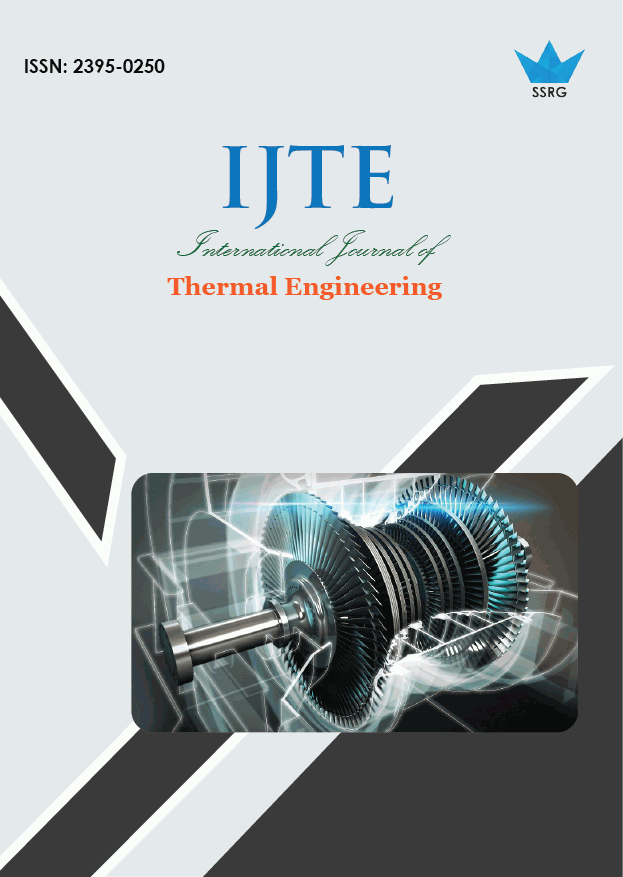Heat Transfer, Fluid Mechanics and Energy Analysis of an Industrial Roller Ironing Machine

| International Journal of Thermal Engineering |
| © 2025 by SSRG - IJTE Journal |
| Volume 11 Issue 2 |
| Year of Publication : 2025 |
| Authors : Sercan Acarer, Kader Sever, Can Çivi |
How to Cite?
Sercan Acarer, Kader Sever, Can Çivi, "Heat Transfer, Fluid Mechanics and Energy Analysis of an Industrial Roller Ironing Machine," SSRG International Journal of Thermal Engineering, vol. 11, no. 2, pp. 11-15, 2025. Crossref, https://doi.org/10.14445/23950250/IJTE-V11I2P102
Abstract:
In this study, energy, heat transfer, and fluid flow analyses were conducted for an industrial roller ironer, a system that has received limited attention in the scientific literature. These machines simultaneously dry and press flat textiles by conveying them between a rotating roller and a stationary heated chest. A high and uniform surface temperature is maintained via thermal oil circulation within the chest, enabling rapid moisture evaporation and fabric smoothing. This system is widely employed in industrial laundries for high-throughput ironing. Two operating conditions are considered, one with pre-dried fabric (faster ironing) and one without pre-drying (slower ironing), both requiring the same heat load. A single Conjugate Heat Transfer (CHT) CFD simulation was performed under this heat load to represent both scenarios. The simulations yielded the surface heat load and temperature distribution, revealing localized regions of low heat flux. These zones were attributed to complex three-dimensional flow separation occurring at the U-bends of the internal oil channels, which impair local heat transfer. Design modifications were proposed to mitigate these deficiencies. Overall, the analysis indicates uniform thermal performance across the ironing surface, with targeted areas for further improvement.
Keywords:
Heat transfer, CHT, CFD, Industrial Ironer, Thermal Oil Heated Flatwork Ironer.
References:
[1] Ali Hasanbeigi, and Lynn Price, “A Review of Energy Use and Energy Efficiency Technologies for the Textile Industry,” Renewable and Sustainable Energy Reviews, vol. 16, no. 6, pp. 3648-3665, 2012.
[CrossRef] [Google Scholar] [Publisher Link]
[2] Grégorio Crini et al., “Characterization and Treatment of Industrial Laundry Wastewaters: A Review,” Environmental Chemistry Letters, vol. 22, pp. 2257-2292, 2024.
[CrossRef] [Google Scholar] [Publisher Link]
[3] D. Rogale and S. FirštRogale, “Energy and Environmental Aspects of the Sustainability of Clothing Production,” Sustainability, vol. 16, no. 20, pp. 1-30, 2024.
[CrossRef] [Google Scholar] [Publisher Link]
[4] Ahmet Çay, “Energy Consumption and Energy Saving Potential in Clothing Industry,” Energy, vol. 159, pp. 74-85, 2018.
[CrossRef] [Google Scholar] [Publisher Link]
[5] S. Palamutcu, “Electric Energy Consumption in the Cotton Textile Processing Stages,” Energy, vol. 35, no. 7, pp. 2945-2952, 2010.
[CrossRef] [Google Scholar] [Publisher Link]
[6] Abdullah Al Mamun et al., “Energy Consumption Modeling in Industrial Sewing Operations: A Case Study on Carbon Footprint Measurement in the Apparel Industry,” Manufacturing Letters, vol. 41, pp. 1635-1644, 2024.
[CrossRef] [Google Scholar] [Publisher Link]
[7] Betül Özer, and Behçet Güven, “Energy Efficiency Analyses in a Turkish Fabric Dyeing Factory,” Energy Sources, Part A: Recovery, Utilization and Environmental Effects, vol. 43, no. 7, pp. 852-874, 2021.
[CrossRef] [Google Scholar] [Publisher Link]
[8] S. Sakti, B.M. Sopha, and E.S.T. Saputra, “Energy Efficiency Analysis in a Textile Company Using DMAIC Approach,” IOP Conference Series: Materials Science and Engineering, vol. 1096, no. 1, pp. 1-12, 2021.
[CrossRef] [Google Scholar] [Publisher Link]
[9] R. Korycki, and H. Szafrańska, “Optimisation of Pad Thicknesses in Ironing Machines during Coupled Heat and Mass Transport,” Fibres and Textiles in Eastern Europe, vol. 24, no. 1, pp. 128-135, 2016.
[CrossRef] [Google Scholar] [Publisher Link]
[10] Zhibin Xie, and Baoshou Sun, “Research of Ironing Product by Saturated Steam Thermal Energy,” Proceedings of the 2010 International Conference on Measuring Technology and Mechatronics Automation, Changsha, China, pp. 1087-1090, 2010.
[CrossRef] [Google Scholar] [Publisher Link]
[11] Changsang Yun et al., “Sustainable Care of Textile Products and Its Environmental Impact: Tumble-Drying and Ironing Processes,” Fibers and Polymers, vol. 18, no. 3, pp. 590-596, 2017.
[CrossRef] [Google Scholar] [Publisher Link]

 10.14445/23950250/IJTE-V11I2P102
10.14445/23950250/IJTE-V11I2P102